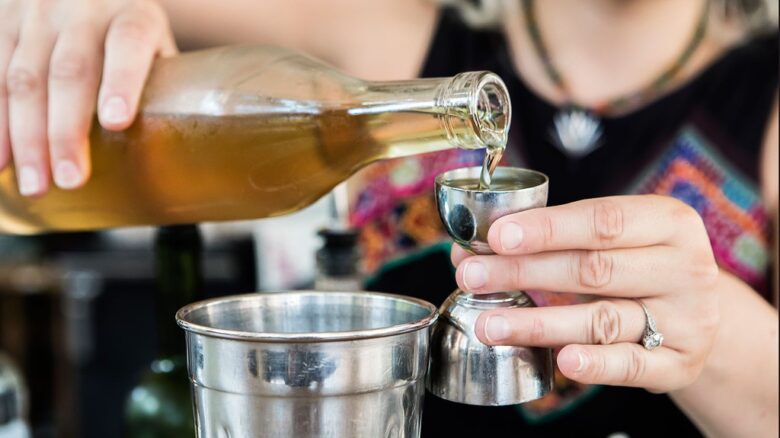Falernum. You may know what it is, and you may not. You may even have a bottle in your home bar. And even if you have never heard of it, if you have had a properly made Tiki drink – you have likely had it without knowing. Falernum is in some ways the Caribbean seasoning of simple syrup. People often ask me, why are so many cocktails sweet, or why do you put sugar into a cocktail? The sweet component has several important roles in a cocktail. It balances out and manners the tartness of the citrus or harshness of the spirit, and it also adds thickness to the drink, which makes it more luxurious in your mouth. Like salt, though, too much of a good thing is bad, and you don’t want the drink to tip into the cloying (excessively sweet) range. Many subscribe to the Golden Rule of cocktails – 2 parts spirit, 1 part sour, and 1 part sweet (and water in the form of ice). This is the basic formula for the classic daiquiri and the margarita.
Ever since men and women have been mixing drinks, they have been experimenting with the four parts of the drink. But while there are several different types of spirits (rye, vodka, rum) and types of citrus (lime, orange, passion fruit, mango), the sweet element is where the most variation lies. By sometime in the early 1800s (possibly earlier) bartenders were preparing simple syrup to speed up the drink making process, dissolving sugar into water in advance, and providing two of the four elements at once. This quickly evolved into cane, beet, demerara, and turbinado simple syrups for the sake of variety and taste. By the late 1800s inventive mixologists (yes that term has been around that long) started using fortified wines and vermouth, liqueurs (Chartreuse, Benedictine, Chambord, Cherry Heeling, Cointreau/triple sec, absinthe) and crème liqueurs (crème de cacao, crème de menthe, Irish cream, Curaçao), as well as amari (Campari, Aperol, Averna, Amer Picon). Which brings us back to the Caribbean Falernum.
Falernum (fə-LUR-nəm) was created sometime in the 1700s, likely in Barbados, as a punch. It is doubtful that this matches up with the taste profile of the liqueur we see today, but it is a rum-based liqueur that contains the flavors of lime, ginger and almonds and to a lessor degree cloves and allspice. The amount of sugar defines the thickness or viscosity, and while the liqueur can be made alcohol-free, the rum makes the liquid shelf stable. There is some debate as to whether the early versions contained almonds, and instead included wormwood and other bitters. In 1892 it was described as “a curious liqueur composed from rum and lime” in the magazine ‘All the Year Round’.

But it didn’t really take off until the 1930s when Ernest Raymond Beaumont Gantt, aka Donn Beach, aka Don the Beachcomber began using it as a sweet component in his exotic cocktails that would later be rebranded as Tiki drinks. It is an essential component in Beach’s Zombie, Three Dots and a Dash, the Test Pilot, and Vicious Virgin, as well as the Bermuda Rum Swizzle, the Corn ‘n Oil, and Saturn cocktails. The liqueur seems to bottle the flavor of the Caribbean and distill the essence of the islands. Being rum-based, it is a natural for the “Rhum Rhapsodies” that sprang from the mind of Beach. As he was fond of saying, “If you can’t get to paradise, I’ll bring it to you”. It was quickly embraced by Trader Vic, and the host of those cashing in on the Tiki craze.
But as America, and the world, moved away from complex cocktails with lots of fresh ingredients to canned and bottled fruit juice mixed with the vodka, starting in the latter half of the 1960s, those old cocktails fell out of fashion. And along with it the ingredients that made them special. By the 1990s when the craft cocktail movement woke up from its three-decade coma, bartenders became aware of lost recipes for hauntingly enticing drinks made with ingredients that could no longer be found. Not only were recipes for drinks like the Zombie lost, but so was falernum.
The liqueur was still available in Barbados, but it was not to be found in America. Early pioneers in the cocktail renaissance hunted down ‘dead stock’ from liquor stores that had gone out of business, cajoled importers to obtain as many bottles as possible, and even convinced niche distillers to make their own. Pre-prohibition cocktail historian Ted Haigh, author of ‘Vintage Spirits & Forgotten Cocktails,’ obtained a number of bottles from the Sazerac Co. before they halted production due to lack of sales, and Tiki historian Jeff ‘Beachbum’ Berry bought up as much dead stock as he could find and estimates that only ten percent was drinkable. Together the two convinced Fee Brothers to produce the liqueur domestically based on old bottles they had. And influential bartenders like Dale DeGroff pestered their suppliers while making crowed-favorite drinks with what they could get their hands on. Soon the liqueur was once again available, thanks to distribution opening back up in the Caribbean, and domestically produced product.

The liqueur is now relatively easy to find. With the recipes now known, it is not difficult to make at home (I have – it’s delicious), but when you can purchase a bottle of John D. Taylor Velvet Falernum for around $20, why would you. It is crystal clear, so it won’t affect your cocktail color, is made in Barbados, and is considered by many to be the original recipe.
So go out and buy a bottle. Use it to make a classic Tiki cocktail, or just use it in place of simple syrup and see what lovely results come out of the experiment.
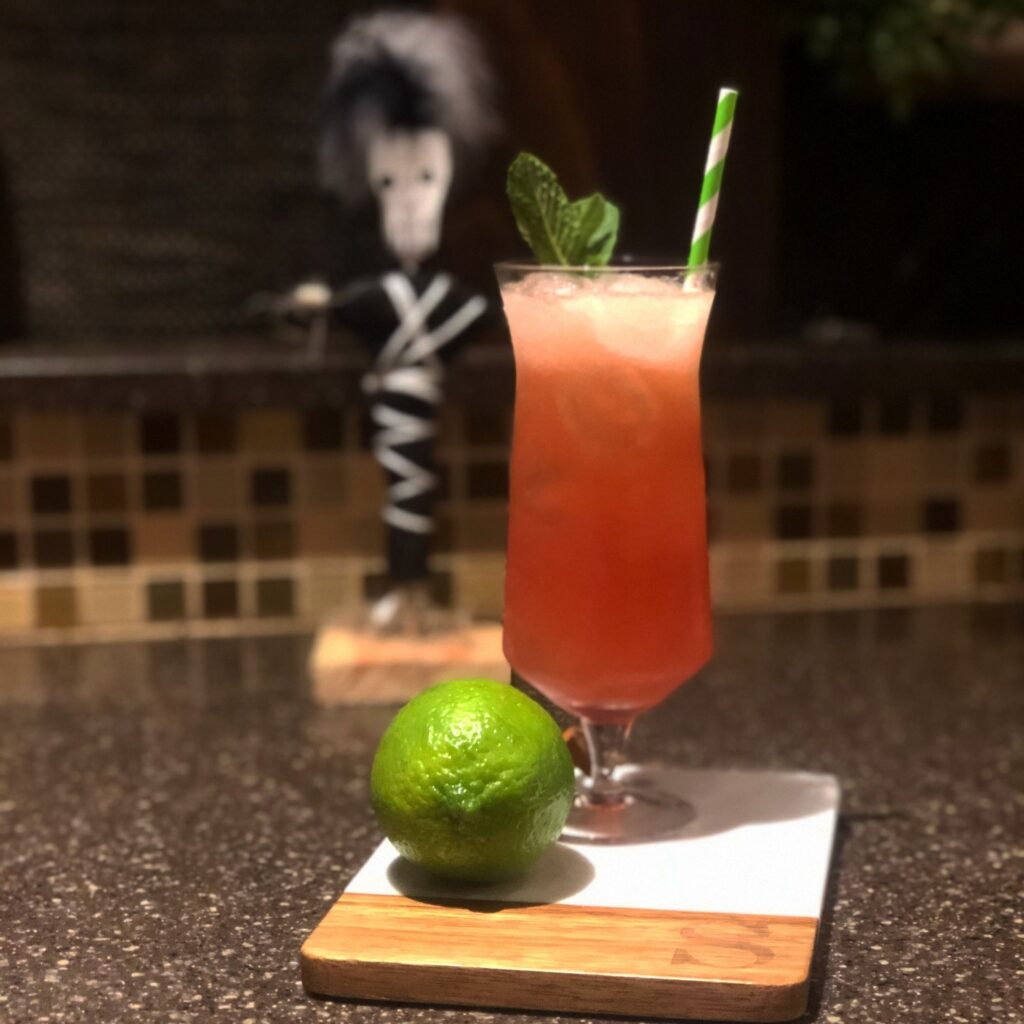
The Zombie
1-1/2oz Jamaican Rum
1-1/2oz gold Puerto Rican rum
1oz 151 rum
1/8tsp absinthe
1/2oz Velvet Falernum
1/2oz Donn’s Mix
1tsp pomegranate grenadine
3/4oz fresh lime juice
1 dash Angostura Bitters
Mint sprig garnish.
Add everything to a blender along with 6oz of crushed ice. Blend for no more than 5 seconds. Pour into a hurricane glass and add ice to fill. Place the mint sprig in your palm and slap your hands together sharply to release the oils in the mint. Add to the cocktail, add a straw, and serve.
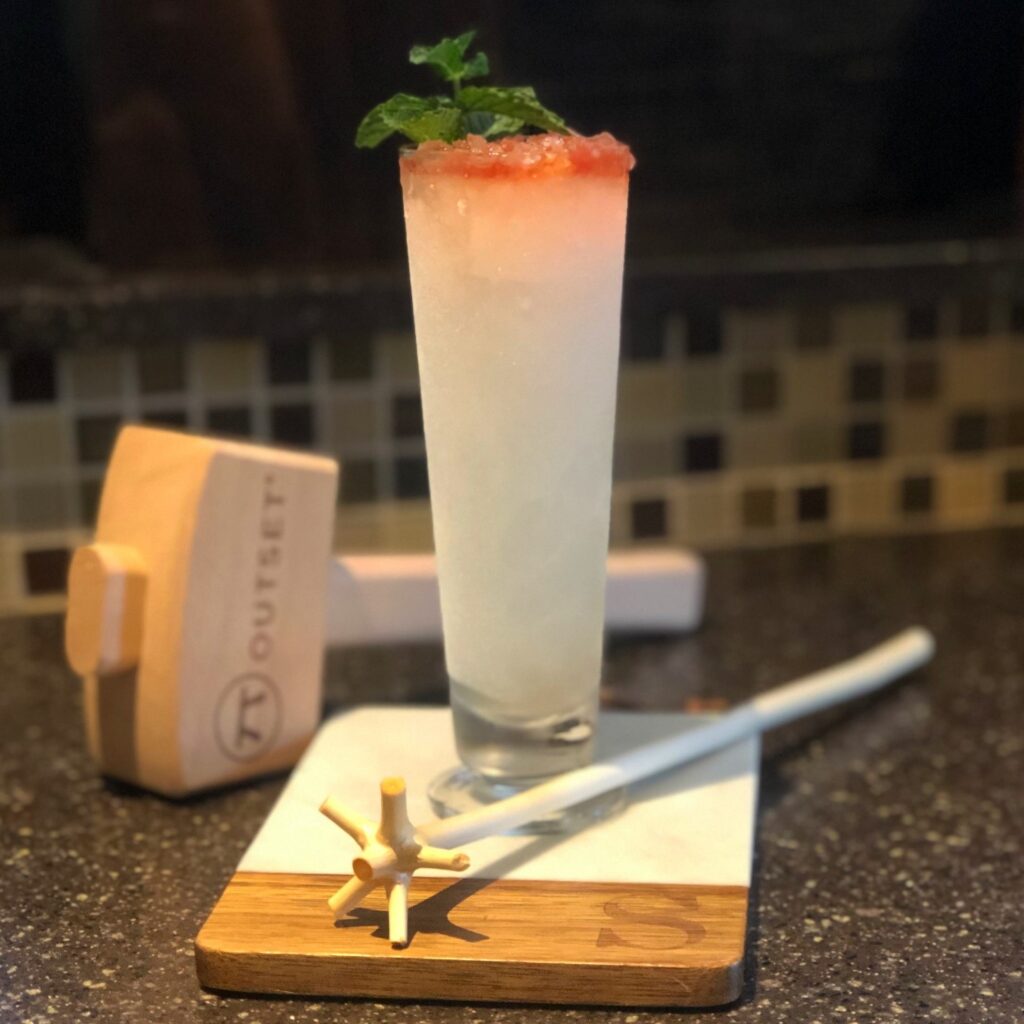
The Green Swizzle
2oz Old Tom gin
1oz Velvet Falernum
1oz lime juice
2oz soda water (optional)
1 bar spoon wormwood bitters
Angostura bitters
Sprig of mint garnish
Fill a Collins or Sling glass with shaved ice. Ice should be like snow, so shave it or pound it out in a Lewis bag until powder. Fill glass with shaved ice and place a le bois lélé stick in (or a bar spoon). Add rum (Old Tom, Plymouth, or Jenever gin have as much claim to authenticity here), falernum, lime, and wormwood bitters to a mixing glass pour into the glass. Using the palms of your hands, rotate the swizzle stick/bar spoon and raise up and down until the glass frosts over. Add more ice if needed (and soda water if desired), and 12 dashes of Angostura bitters to create a bitter cap on the drink. Add the mint and a straw and serve.
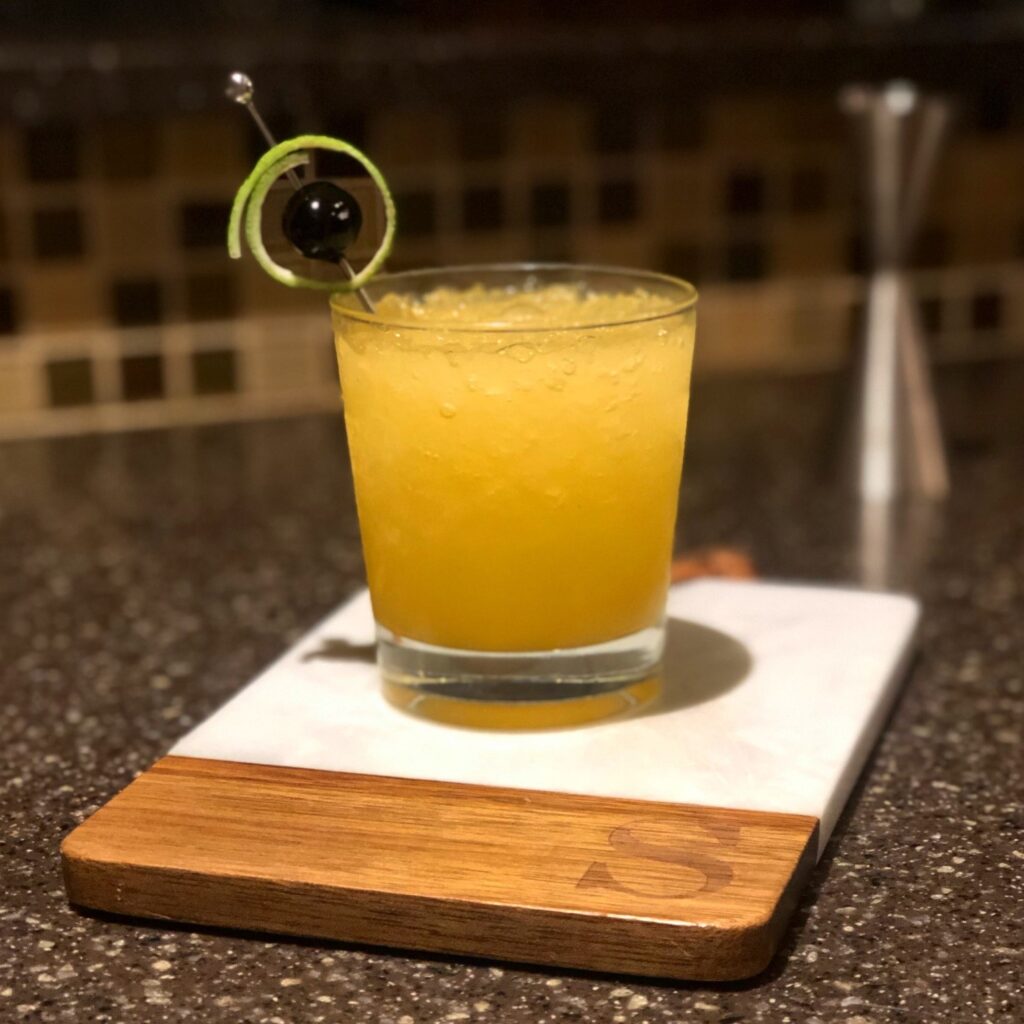
The Saturn Cocktail
1 1/2oz London dry gin
1/2oz fresh lemon juice
1/4oz passion fruit puree
1/4oz Velvet Falernum
1/2oz orgeat
Luxardo cherry garnish (Saturn)
Lime peel garnish (Saturn’s ring)
Cut a long thin strip of lime peel and wrap the cherry to create Saturn with its ring as a garnish and set aside. Fill a double rocks glass with crushed ice, then add everything to a blender with an additional 8oz of crushed ice. Pulse blend for 3-5 seconds, then pour into the glass over the ice. Add the garnish and serve.
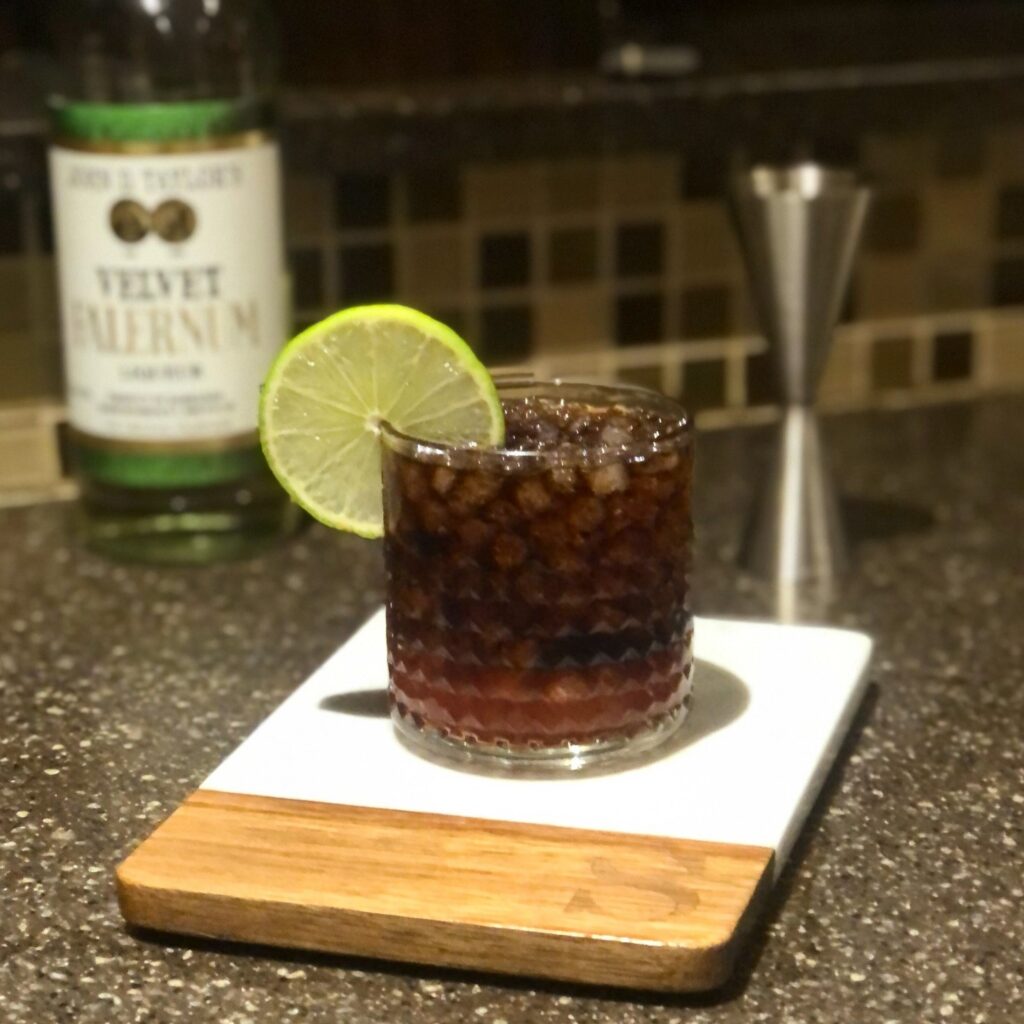
Corn n’ Oil
2oz black strap rum (or other dark, aged rum)
3/4oz Velvet Falernum
1/2oz fresh lime juice
3 dashes Angostura bitters
Lime wedge or wheel garnish
Add the lime, falernum, and bitters to a rocks glass filled with cracked or pebble ice, then slowly float the black strap over the back of a bar spoon to layer the drink. Add the garnish and serve (give it a stir before sipping).
Cheers!
Bill
AotCB-037
